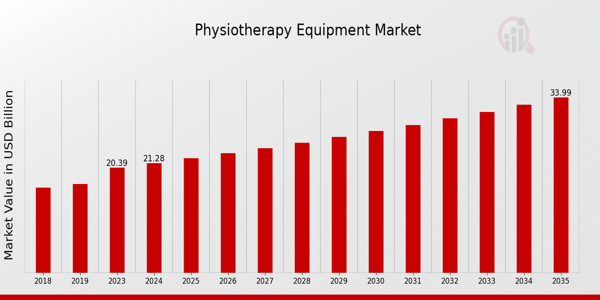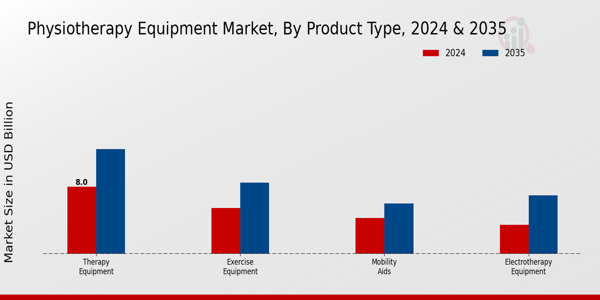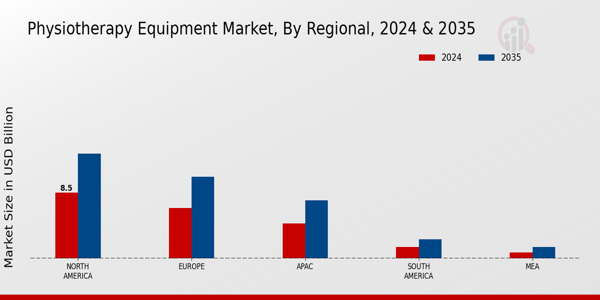Physiotherapy Equipment Market Overview
The Physiotherapy Equipment Market Size was estimated at 20.39 (USD Billion) in 2023. The Physiotherapy Equipment Market Industry is expected to grow from 21.28(USD Billion) in 2024 to 34.0 (USD Billion) by 2035. The Physiotherapy Equipment Market CAGR (growth rate) is expected to be around 4.35% during the forecast period (2025 - 2035).
Key Physiotherapy Equipment Market Trends Highlighted
The Global Physiotherapy Equipment Market is witnessing significant growth driven by an increasing awareness of the importance of physical health and rehabilitation across various populations. The rise in chronic diseases and injuries has prompted individuals to seek professional rehabilitation services, leading to a higher demand for physiotherapy equipment. Additionally, the aging population is contributing to the need for effective therapeutic solutions, fostering innovation in equipment design and functionality. Furthermore, advancements in technology, including telehealth services, are enhancing accessibility to physiotherapy, which positively affects market expansion.
There are numerous opportunities within the market waiting to be explored. Manufacturers can benefit from developing advanced, user-friendly physiotherapy devices that integrate smart technology, which can improve patient outcomes. The growing trend of home care physiotherapy also presents a unique opportunity for companies to develop portable equipment tailored for home use. Collaboration with healthcare providers to create comprehensive rehabilitation programs further enhances the market's potential. Emerging markets in developing countries show promise due to increasing healthcare investments and rising awareness about physiotherapy services.
Recent trends highlight the growing emphasis on preventive care in physiotherapy, shifting focus from rehabilitation to overall wellness. Digital health solutions, such as mobile apps and wearable devices, are being integrated into traditional physiotherapy practices to enhance patient engagement and adherence to treatment plans. Online consultation services are becoming more prevalent, providing remote access to physiotherapy and making it easier for patients to receive care. These trends indicate a dynamic market landscape that is continuously evolving, driven by technological advancements and changing patient needs.

Source: Primary Research, Secondary Research, MRFR Database and Analyst Review
Physiotherapy Equipment Market Drivers
Increasing Prevalence of Musculoskeletal Disorders
The Global Physiotherapy Equipment Market industry is significantly driven by the rising prevalence of musculoskeletal disorders. These disorders, which affect the bones, muscles, and joints, are among the leading causes of chronic pain and disability worldwide. As the population ages and lifestyle changes lead to more sedentary habits, the number of individuals suffering from these conditions is surging. This trend has resulted in a growing demand for advanced physiotherapy equipment that can aid in faster recovery and rehabilitation.
As more patients seek physiotherapy services to manage pain and regain mobility, healthcare providers are encouraged to invest in state-of-the-art equipment. Moreover, healthcare facilities are recognizing the importance of adopting specialized physiotherapy equipment to enhance treatment outcomes and patient satisfaction. As the market evolves, innovative solutions that integrate technology, such as telerehabilitation and digital monitoring, are gaining traction.These innovations enhance the quality of physiotherapy treatments and similarly broaden the scope of patients that can access the services which has a positive impact on the Global Physiotherapy Equipment Market. The growth and development of the sector will be encouraged and stimulated by the expected increased demand for various types of physiotherapy equipment, which will be necessary to improve treatment outcomes.
Technological Advancements in Treatment Equipment
Technological innovations play a crucial role in driving the Global Physiotherapy Equipment Market industry forward. With the introduction of advanced equipment featuring smart technologies and robotics, physiotherapy practices are evolving at a rapid pace. These cutting-edge tools enhance treatment precision and improve patient outcomes, making them essential for modern physiotherapy practices. As the industry embraces new technologies, practitioners are empowered to provide more effective, individualized treatment regimens.
The integration of data analytics and telehealth in physiotherapy equipment also streamlines patient monitoring and engagement, facilitating better recovery rates.
Rising Awareness of Physical Rehabilitation
The growing awareness regarding the importance of physical rehabilitation is fueling the expansion of the Global Physiotherapy Equipment Market. As more people understand the benefits of physiotherapy in recovering from injuries and surgeries, the demand for physiotherapy services and equipment is rising. Increased awareness supports preventive care and helps individuals understand their health options better, leading to a larger pool of patients seeking services from physiotherapists.
This trend is further amplified by community health initiatives and campaigns that highlight the significance of maintaining a healthy lifestyle and addressing physical ailments through appropriate interventions.
Physiotherapy Equipment Market Segment Insights
Physiotherapy Equipment Market Product Type Insights
The Global Physiotherapy Equipment Market, particularly within the Product Type segment, showcases a diverse landscape characterized by various categories that contribute significantly to its overall valuation. As of 2024, the market is expected to be valued at 21.28 USD Billion, reflecting a robust growth trajectory driven by an increasing demand for rehabilitation services globally. Among the categorized offerings, Therapy Equipment emerges as a considerable player, holding a valuation of 8.0 USD Billion in 2024, rising to 12.5 USD Billion by 2035. This dominance is attributed to the growing need for effective treatment modalities and rehabilitation processes, especially in aging populations seeking recovery from surgeries and injuries.
Similarly, the Exercise Equipment type is vital within the Global Physiotherapy Equipment Market, with its valuation pegged at 5.5 USD Billion in 2024, and it is projected to advance to 8.5 USD Billion by 2035. This segment plays a crucial role due to the increasing awareness of fitness and preventive health measures, thereby emphasizing the necessity for physiotherapeutic exercises tailored to diverse patient needs. Mobility Aids contributed with a valuation of 4.3 USD Billion in 2024, expected to elevate to 6.0 USD Billion by 2035, underscoring its significance in enhancing patient independence and mobility, particularly for the elderly and those with physical limitations.
Electrotherapy Equipment, valued at 3.5 USD Billion in 2024, aims to reach 7.0 USD Billion by 2035, reflecting its rising relevance in modern physiotherapy practices. The technology that underpins this segment is essential in pain management and tissue healing, facilitating quicker recovery processes for patients. Such advancements highlight the segment's importance in a market landscape where technological integration is becoming increasingly prominent. Altogether, the segmentation of the Global Physiotherapy Equipment Market portrays a mixed yet complementary growth profile, delineated by the varied demands placed on each product type as healthcare continues to evolve. Each category not only fulfills unique therapeutic needs but also showcases opportunities for healthcare providers to enhance the quality of care, meet regulatory standards, and improve patient outcomes across different demographics, leveraging the ongoing trends that prioritize rehabilitation and wellness.

Source: Primary Research, Secondary Research, MRFR Database and Analyst Review
Physiotherapy Equipment Market Application Insights
The Global Physiotherapy Equipment Market revenue showcases this growth can be attributed to increasing health awareness and a rising prevalence of musculoskeletal disorders. Within the Application segment, Orthopedic and Neurological domains are particularly significant, driven by a surge in the population requiring rehabilitation post-surgery or injury. Pediatric physiotherapy has gained importance due to heightened awareness regarding children's developmental issues, necessitating tailored therapeutic solutions.
Sports Medicine is dominating the market as more athletes and fitness enthusiasts seek physiotherapy interventions to enhance performance and expedite recovery from injuries. The diverse applications of physiotherapy equipment across these areas not only support effective recovery but also provide a robust market growth platform, highlighting the market's potential corresponding to the evolving healthcare landscape. The overall market growth is further accentuated by advancements in technology and increasing investment in healthcare infrastructure.
As such, the segmentation of the Global Physiotherapy Equipment Market data emphasizes the criticality of these applications in addressing varying patient needs in a compelling manner.
Physiotherapy Equipment Market End User Insights
The Global Physiotherapy Equipment Market is a dynamic sector with substantial revenue generated from its diverse End User categories. Hospitals play a pivotal role in the market as they continuously seek advanced equipment to enhance patient treatment outcomes. Rehabilitation centers are also significant contributors, focusing on specialized recovery and rehabilitation services that require a range of physiotherapy devices.
Physiotherapy clinics cater to the increasing number of patients seeking therapy, emphasizing personalized treatment options, while home care services have gained momentum, propelled by the preference for at-home treatment options that ensure patient comfort and convenience. This part of the market highlights the increasing trend of personalized care and the focus on recovery, signaling growth opportunities in these segments. The interplay of these segments illustrates the broader Global Physiotherapy Equipment Market statistics, exhibiting a shift toward accessible and patient-centric care across various settings.
Physiotherapy Equipment Market Distribution Channel Insights
The Global Physiotherapy Equipment Market revenue has shown robust growth dynamics, Focusing on the Distribution Channel, various pathways such as Direct Sales, Online Sales, and Distributors play a pivotal role in shaping market dynamics. Direct Sales often allow for personalized interactions with customers, contributing to customer loyalty and satisfaction. Online Sales have increasingly gained traction due to the convenience and accessibility offered to consumers, particularly as digital transformations in healthcare continue to expand.
Meanwhile, Distributors operate as essential intermediaries, facilitating wider reach and making equipment available across diverse geographical areas. Each of these channels not only contributes to the overall Global Physiotherapy Equipment Market statistics but also addresses different customer needs, thus being crucial for market growth and adaptability in response to emerging trends such as telehealth and home rehabilitation. Therefore, understanding the Global Physiotherapy Equipment Market segmentation within the Distribution Channel is fundamental for stakeholders aiming to leverage opportunities amid evolving consumer behaviors and preferences.
Physiotherapy Equipment Market Regional Insights
The Global Physiotherapy Equipment Market has shown substantial growth across regional segments, with North America leading the way, holding a market value of 8.5 USD Billion in 2024 and increasing to 13.5 USD Billion by 2035. This significant position reflects a strong healthcare infrastructure and growing demand for rehabilitation services. Europe follows with a valuation of 6.5 USD Billion in 2024, rising to 10.5 USD Billion in 2035, indicating its robust healthcare system and a growing elderly population that drives the need for physiotherapy.
The APAC region, valued at 4.5 USD Billion in 2024 and projected to grow to 7.5 USD Billion by 2035, is gaining traction due to increasing healthcare expenditure and awareness of physiotherapy benefits. In contrast, South America and MEA hold smaller shares, valued at 1.5 USD Billion and 0.8 USD Billion in 2024, respectively, but are expected to show growth as healthcare systems develop. The disparities in market sizes highlight the dominance of North America and Europe, while APAC presents substantial potential for future market growth driven by improving economies and healthcare access.

Source: Primary Research, Secondary Research, MRFR Database and Analyst Review
Physiotherapy Equipment Market Key Players and Competitive Insights
The Global Physiotherapy Equipment Market has experienced significant growth in recent years, fueled by advancements in technology, an increasing awareness of the importance of rehabilitation, and a rising geriatric population. As healthcare continues to evolve, the demand for physiotherapy equipment is becoming more pronounced, with a wide range of devices being utilized for various therapeutic applications.
The competitive landscape of this market is characterized by the presence of both established players and emerging companies striving to innovate and offer superior products. Key drivers of competition include product quality, technological advancements, customer service, and the capacity to meet specific rehabilitation needs. Companies within this space are continually focusing on research and development to enhance their product offerings and effectively respond to the dynamic demands of healthcare providers, thus shaping the future of physiotherapy treatment and management.
HUR has established itself as a strong contender in the Global Physiotherapy Equipment Market by emphasizing its focus on high-quality and innovative products designed for rehabilitation and physiotherapy. With a commitment to enhancing the efficiency of rehabilitation processes, HUR is recognized for its unique technology that integrates strength training with rehabilitation.
The company effectively blends biomechanics with customized software solutions, allowing practitioners to tailor rehabilitation programs to individual patients' needs. This adaptability enhances treatment outcomes, making HUR a preferred choice among physiotherapy professionals. In addition, HUR’s extensive research and development efforts ensure that their product lineup remains at the forefront of technology, further strengthening their market presence. The company's dedication to training and support for healthcare practitioners ensures the successful implementation of its equipment, contributing to its reputation as a trusted partner in physiotherapy.
Chattanooga, another key player in the Global Physiotherapy Equipment Market, has gained recognition for its wide range of therapeutic modalities and innovative products tailored to enhance patient care in rehabilitation settings. Known for its advanced treatment solutions, Chattanooga specializes in medical devices that encompass ultrasound therapy, electrotherapy, and traction systems.
This extensive array of equipment allows physiotherapists to address various conditions effectively and provides a comprehensive approach to rehabilitation. Furthermore, Chattanooga's commitment to quality assurance and continuous product improvement positions it as a preferred brand among healthcare professionals. The company's strong global presence, reinforced by strategic partnerships and a focus on customer support, has significantly contributed to its competitive edge in the market, enabling it to maintain a loyal customer base and expand its reach within the physiotherapy sector.
Key Companies in the Physiotherapy Equipment Market Include
- HUR
- Chattanooga
- Omron
- Kessler Rehabilitation
- BTL Industries
- BodyBalance
- Hydrocollator
- DJO Global
- TheraGun
- Zynex
- NuMotion
- Medtronic
- Fysiomed
- Homewell
- Tennant
Physiotherapy Equipment Market Industry Developments
Recent developments in the Global Physiotherapy Equipment Market indicate a significant growth trajectory driven by an increasing focus on rehabilitation and patient care. Companies such as HUR and Chattanooga are innovating with advanced technologies that enhance therapeutic outcomes and patient engagement. Omron and BTL Industries continue to expand their portfolios with state-of-the-art electronic devices and modalities to improve treatment efficacy.
Notably, a marked interest in wearable technology and home-based physiotherapy solutions has been observed, indicating a shift towards more accessible rehabilitation options for patients. In terms of mergers and acquisitions, DJO Global has made headlines with its acquisition of TheraGun, further solidifying its position in the market with advanced recovery equipment.
Additionally, Zynex's recent expansion into the European market reflects a growing global footprint and the demand for innovative physiotherapy solutions. The overall market valuation is witnessing an upward trend, with companies like Medtronic and NuMotion capitalizing on this momentum to enhance their product offerings. This increasing market activity suggests a robust environment for both existing and emerging players, enhancing their ability to cater to the evolving needs of healthcare providers and patients alike.
Physiotherapy Equipment Market Segmentation Insights
-
Physiotherapy Equipment Market Product Type Outlook
- Therapy Equipment
- Exercise Equipment
- Mobility Aids
- Electrotherapy Equipment
-
Physiotherapy Equipment Market Application Outlook
- Orthopedic
- Neurological
- Pediatric
- Sports Medicine
-
Physiotherapy Equipment Market End User Outlook
- Hospitals
- Rehabilitation Centers
- Physiotherapy Clinics
- Home Care
-
Physiotherapy Equipment Market Distribution Channel Outlook
- Direct Sales
- Online Sales
- Distributors
-
Physiotherapy Equipment Market Regional Outlook
- North America
- Europe
- South America
- Asia Pacific
- Middle East and Africa
Scope:
| Attribute/Metric Source: |
Details |
| MARKET SIZE 2023 |
20.39(USD Billion) |
| MARKET SIZE 2024 |
21.28(USD Billion) |
| MARKET SIZE 2035 |
34.0(USD Billion) |
| COMPOUND ANNUAL GROWTH RATE (CAGR) |
4.35% (2025 - 2035) |
| REPORT COVERAGE |
Revenue Forecast, Competitive Landscape, Growth Factors, and Trends |
| BASE YEAR |
2024 |
| MARKET FORECAST PERIOD |
2025 - 2035 |
| HISTORICAL DATA |
2019 - 2024 |
| MARKET FORECAST UNITS |
USD Billion |
| KEY COMPANIES PROFILED |
HUR, Chattanooga, Omron, Kessler Rehabilitation, BTL Industries, BodyBalance, Hydrocollator, DJO Global, TheraGun, Zynex, NuMotion, Medtronic, Fysiomed, Homewell, Tennant |
| SEGMENTS COVERED |
Product Type, Application, End User, Distribution Channel, Regional |
| KEY MARKET OPPORTUNITIES |
Telehealth integration, Increasing geriatric population, Rising sports injuries, Advancements in wearable technology, Growing demand for rehabilitation services |
| KEY MARKET DYNAMICS |
Growing aging population, Rising prevalence of chronic diseases, Technological advancements in equipment, Increasing health awareness, Expanding healthcare infrastructure |
| COUNTRIES COVERED |
North America, Europe, APAC, South America, MEA |
Frequently Asked Questions (FAQ) :
The Global Physiotherapy Equipment Market is expected to be valued at 21.28 USD Billion in 2024.
The expected CAGR for the Global Physiotherapy Equipment Market from 2025 to 2035 is 4.35%.
North America is projected to have the largest market size at 8.5 USD Billion in 2024.
The expected market value for Therapy Equipment is projected to be 12.5 USD Billion by 2035.
Major players in the market include HUR, Chattanooga, Omron, Kessler Rehabilitation, and Medtronic.
The market size for Exercise Equipment is expected to reach 8.5 USD Billion in 2035.
The forecasted market value for Mobility Aids is 4.3 USD Billion in 2024.
The projected market value for Electrotherapy Equipment by 2035 is 7.0 USD Billion.
In 2024, the market size in Europe is valued at 6.5 USD Billion, which is lower than North America's 8.5 USD Billion.
The expected market value for the MEA region by 2035 is projected to be 1.5 USD Billion.
















